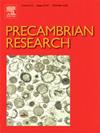Early Paleoproterozoic mafic to felsic magmatism from the Cuoke Complex, South China: Implications for the early tectonic evolution of the southwestern Yangtze Craton
IF 3.2
2区 地球科学
Q2 GEOSCIENCES, MULTIDISCIPLINARY
引用次数: 0
Abstract
The early Paleoproterozoic architecture and tectonic evolution of the Yangtze Craton in present-day southern China remain poorly understood due to the limited outcrops of rocks from this period. The recently discovered Cuoke Complex in the southwestern Yangtze Craton preserves numerous early Paleoproterozoic igneous rocks, providing a valuable opportunity to investigate the early evolution of the Yangtze Craton. On the basis of lithological features, magmatic zircon U–Pb–Lu–Hf isotopes, and whole-rock geochemical characteristics, four main lithological assemblages have been identified, and their petrogeneses have been revealed. (1) The ca. 2.36 Ga monzogranites have low Zr + Nb + Ce + Y contents (155–267 ppm), high A/CNK ratios (1.14–1.42), and low 10,000*Ga/Al ratios (1.66–2.50), which are typical of S-type granites. These monzogranites display negative whole-rock εNd(t) (−4.7 to −7.6) and zircon εHf(t) values (−2.4 to −4.8) and high CaO/Al2O3 (0.01–0.08) and CaO/Na2O ratios (0.04–0.32), suggesting that they formed through the remelting of ancient pelites. (2) The ca. 2.33 Ga diorites are characterized by high Sr contents (556–619 ppm), high Sr/Y (63.0–83.1) and (La/Yb)N ratios (24.7–28.1), and low Y (7.45–9.17 ppm) and Yb (0.94–1.11 ppm) contents; thus, these rocks resemble adakites. The elevated Mg# values (46–56), high Cr (106–125 ppm) and Ni (38.9–43.9 ppm) contents, and positive εNd(t) (+2.4 to + 4.2) and εHf(t) values (+1.4 to + 8.4) indicate that these rocks originated from the partial melting of a subducted oceanic slab. (3) The ca. 2.32 Ga mafic rocks exhibit typical Nb-enriched basaltic features, with high TiO2 (2.08–3.94 wt%) and Nb (7.63–16.7 ppm) contents and elevated Nb/Th (4.85–11.7), Nb/La (0.33–0.87), and Nb/U (13.4–32.1) ratios. The rocks have decoupled Nd–Hf isotopes with relatively low whole-rock εNd(t) (+2.1 to + 3.6) values and relatively high zircon εHf(t) (+2.2 to + 9.0) values, suggesting that they were derived from a mantle wedge modified by slab-derived adakitic melts. (4) The ca. 2.32 Ga granites display high Zr + Nb + Ce + Y contents (451–522 ppm), high 10,000*Ga/Al (2.58–2.69), Y/Nb (1.32–1.94), and Yb/Ta ratios (1.09–1.89), and significantly negative Eu, Ba, Sr, and Ti anomalies, indicating an affinity with A2-type granites. The peraluminous features (A/CNK = 1.05–1.24) and negative whole-rock εNd(t) (−2.9 to −5.5) values and zircon εHf(t) values (−2.1 to −5.1) suggest that these rocks formed through the partial melting of ancient metasedimentary rocks. Considering previous geochronological and geochemical studies of other ancient complexes within the Yangtze Craton, we propose that the ca. 2.36 Ga monzogranites were most likely generated in a syn-collisional setting, whereas the ca. 2.34–2.32 Ga adakites, Nb-enriched mafic rocks, and A2-type granites likely formed in a post-orogenic extensional setting. Furthermore, the southwestern Yangtze Craton and northern Yangtze Craton had independent and spatially distinct evolutionary histories during the Archean to early Paleoproterozoic, with the unified Yangtze Craton most likely forming between 2.00 and 1.93 Ga.
郭克杂岩早古元古代基性-长英质岩浆作用:对扬子克拉通西南部早期构造演化的启示
扬子克拉通早古元古代的构造和构造演化,由于这一时期的岩石露头有限,至今仍知之甚少。最近在扬子克拉通西南部发现的郭克杂岩保存了大量的早古元古代火成岩,为研究扬子克拉通的早期演化提供了宝贵的机会。根据岩石学特征、岩浆锆石U-Pb-Lu-Hf同位素及全岩地球化学特征,确定了4个主要的岩性组合,并揭示了它们的成因。(1)约2.36 Ga二长花岗岩具有低Zr + Nb + Ce + Y含量(155 ~ 267 ppm)、高A/CNK比值(1.14 ~ 1.42)和低10,000*Ga/Al比值(1.66 ~ 2.50)的s型花岗岩特征。二长花岗岩整体εNd(t)为负(- 4.7 ~ - 7.6),锆石εHf(t)为负(- 2.4 ~ - 4.8),CaO/Al2O3(0.01 ~ 0.08)和CaO/Na2O(0.04 ~ 0.32)比值较高,表明它们是由古泥岩重熔形成的。(2) ca. 2.33 Ga闪长岩具有高Sr含量(556 ~ 619 ppm),高Sr/Y(63.0 ~ 83.1)和(La/Yb)N(24.7 ~ 28.1),低Y (7.45 ~ 9.17 ppm)和Yb (0.94 ~ 1.11 ppm)的特征;因此,这些岩石类似埃达克岩。Mg#值(46 ~ 56)升高,Cr (106 ~ 125 ppm)和Ni (38.9 ~ 43.9 ppm)含量高,εNd(t)值(+2.4 ~ + 4.2)和εHf(t)值(+1.4 ~ + 8.4)正,表明这些岩石起源于俯冲洋板的部分熔融。(3)约2.32 Ga基性岩具有典型的富铌玄武岩特征,TiO2 (2.08 ~ 3.94 wt%)和Nb (7.63 ~ 16.7 ppm)含量较高,Nb/Th(4.85 ~ 11.7)、Nb/La(0.33 ~ 0.87)和Nb/U(13.4 ~ 32.1)比值较高。岩石的Nd-Hf同位素解耦合,全岩εNd(t)值较低(+2.1 ~ + 3.6),锆石εHf(t)值较高(+2.2 ~ + 9.0),表明它们来自于经板源阿达质熔体修饰的地幔楔体。(4) ca. 2.32 Ga花岗岩具有较高的Zr + Nb + Ce + Y含量(451 ~ 522 ppm),较高的10,000*Ga/Al比值(2.58 ~ 2.69)、Y/Nb比值(1.32 ~ 1.94)和Yb/Ta比值(1.09 ~ 1.89),以及显著的Eu、Ba、Sr和Ti负异常,与a2型花岗岩具有亲和关系。过铝质特征(A/CNK = 1.05 ~ 1.24)和负的全岩εNd(t)值(−2.9 ~−5.5)和锆石εHf(t)值(−2.1 ~−5.1)表明这些岩石是由古变质沉积岩部分熔融形成的。综合前人对扬子克拉通内其他古杂岩的年代学和地球化学研究,我们认为约2.36 Ga二长花岗岩最有可能形成于同碰撞环境,而约2.34 ~ 2.32 Ga埃达克岩、富镁基岩和a2型花岗岩可能形成于造山后伸展环境。在太古宙至古元古代早期,西南扬子克拉通和北部扬子克拉通具有独立的、空间上不同的进化史,统一的扬子克拉通最有可能形成于2.00 ~ 1.93 Ga之间。
本文章由计算机程序翻译,如有差异,请以英文原文为准。
求助全文
约1分钟内获得全文
求助全文
来源期刊

Precambrian Research
地学-地球科学综合
CiteScore
7.20
自引率
28.90%
发文量
325
审稿时长
12 months
期刊介绍:
Precambrian Research publishes studies on all aspects of the early stages of the composition, structure and evolution of the Earth and its planetary neighbours. With a focus on process-oriented and comparative studies, it covers, but is not restricted to, subjects such as:
(1) Chemical, biological, biochemical and cosmochemical evolution; the origin of life; the evolution of the oceans and atmosphere; the early fossil record; palaeobiology;
(2) Geochronology and isotope and elemental geochemistry;
(3) Precambrian mineral deposits;
(4) Geophysical aspects of the early Earth and Precambrian terrains;
(5) Nature, formation and evolution of the Precambrian lithosphere and mantle including magmatic, depositional, metamorphic and tectonic processes.
In addition, the editors particularly welcome integrated process-oriented studies that involve a combination of the above fields and comparative studies that demonstrate the effect of Precambrian evolution on Phanerozoic earth system processes.
Regional and localised studies of Precambrian phenomena are considered appropriate only when the detail and quality allow illustration of a wider process, or when significant gaps in basic knowledge of a particular area can be filled.
 求助内容:
求助内容: 应助结果提醒方式:
应助结果提醒方式:


